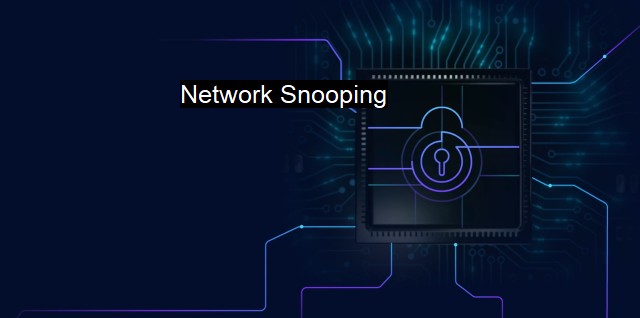What is Network Snooping?
Protecting Your Online Privacy: Unveiling the Silent Threat of Network Snooping in an Era of Digital Insecurity
Network snooping, often referred to as packet sniffing or network monitoring, is a common method utilized within the realm of cybersecurity. Simply put, this process involves the interception, decoding, and analysis of network traffic, making it easier to scrutinize data flow, identify anomalies, or investigate potential security incidents.To understand network snooping in the appropriate context, one must first grasp the basic networking concept. For data to get from one computer system to another, it travels across the network in chunks called packets. These packets, while on their journey, pass numerous points – routers, switches, servers – where they can be intercepted theoretically, thus providing an opportunity for network snooping to take place.
With the introduction to the spheres of the concept, how network snooping works comes as the next query. Packet sniffing applications, which are typically software tools, intercept and log network traffic. They copy all data flowing over a network, split it into data packets, and then scrutinize it for any revealing details. The software collector listens or 'sniffs' the data traveling on the network, demonstrating why such an informative yet invasive measure was dubbed 'snooping.'
There can be various purposes behind network snooping. In an offensively categorised method, bad actors, hackers, and digital adversaries may use network snooping to gain unauthorized access to sensitive information. By monitoring network traffic, the wrong hands can intercept financial details, login credentials, personal data, and other classified information with relative ease, thus jeopardizing cybersecurity.
On the other hand, when employed defensively, network snooping becomes an integral part of maintaining network health and information security. Network administrators often use snooping tools to monitor, troubleshoot, and maintain networks, analyze its performance, and ensure data integrity. Security analysts use this method to detect potential security threats or breaches, investigate, and take mitigating actions based on the insights gained from snooping operations.
Despite the evident advantages, it isn't a surprise that network snooping is often frowned upon because of its risks. The possibility of misusing intercepted information remains a significant concern due to its power to invasively breach privacy barriers. Therefore, legislation like the GDPR in Europe has been arranged, which strictly regulates the processing of personal data multicast across networks.
Lawful use of network snooping can be effectively combined with antivirus solutions to enhance cybersecurity measures. Antivirus software, built around a database of known malware signatures to stop threatening files and programs, plays an vital role in our already compromised digital lives. When paired with trustworthy snooping, it can add another layer of protection.
Antivirus technology linked with network snooping can identify harmful transactions passing through networks, even those seemingly benign but present a damaging potential. For instance, if a device is unknowingly interacting with a malicious website or server and antivirus software picks up malware within the traffic, it can not only instantly block the transaction. Still, it also allows data to use for wider network protection incorporating machine learning and artificial intelligence, contribute to enhancing cyber resilience.
Network snooping, interpreted as a breach or safety measure, has taken its place in the core of cybersecurity. As we continue to tread heavily digital lives where data is a crucial asset, the potential of snooping will be continually revisited and reshaped. It plays a paradoxical role in providing robust cybersecurity while also threatening that same security has aligned with the complexity of our online existence in the digital age. Care should also be taken to check that privacy isn't sidestepped and that the sensitive data which traverse our global networks do so in a fashion that is securely bound by internationally accepted ethical standards.

Network Snooping FAQs
What is network snooping?
Network snooping refers to the act of intercepting and examining network traffic without the knowledge or consent of the parties involved. This is often done to obtain sensitive information such as login credentials, credit card numbers, and other personal data.Why is network snooping a cybersecurity concern?
Network snooping can lead to serious cybersecurity threats, as cybercriminals can use the intercepted information to commit identity theft, financial fraud, and other malicious activities. It can also compromise the privacy and confidentiality of individuals and organizations.How can antivirus software protect against network snooping?
Antivirus software can protect against network snooping by monitoring network traffic and detecting any unauthorized access attempts. It can also identify and block malware that could be used for snooping or other cyberattacks. Additionally, antivirus software can frequently update virus definitions to stay up-to-date with the latest threats.What are some measures individuals and organizations can take to protect against network snooping?
To protect against network snooping, individuals and organizations can take several measures such as using a virtual private network (VPN) to encrypt internet traffic, avoiding public Wi-Fi networks, using strong passwords, keeping software and systems up-to-date, and regularly monitoring network traffic for suspicious activity.| | A | | | B | | | C | | | D | | | E | | | F | | | G | | | H | | | I | | | J | | | K | | | L | | | M | |
| | N | | | O | | | P | | | Q | | | R | | | S | | | T | | | U | | | V | | | W | | | X | | | Y | | | Z | |
| | 1 | | | 2 | | | 3 | | | 4 | | | 7 | | | 8 | | |||||||